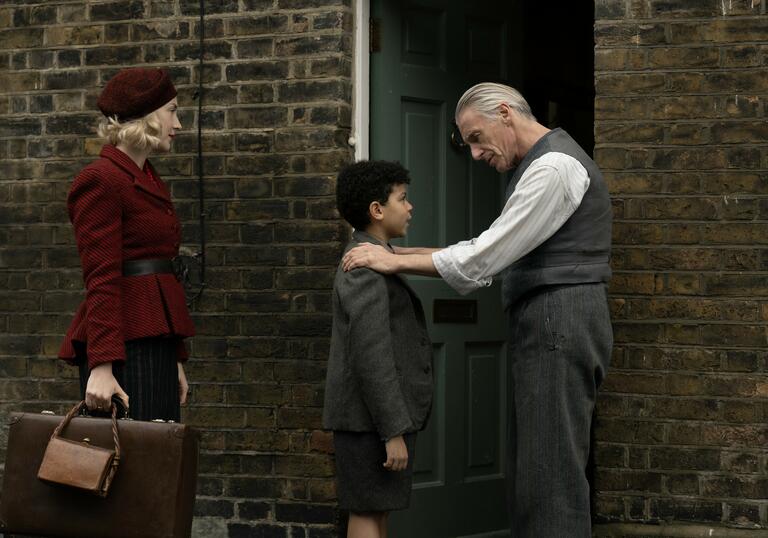How did you go about researching the costumes?
It is interconnected with the whole approach to the film. Steve, from the first time he spoke to me, said that he wanted to make a film about the Blitz that people hadn't seen before. To try to find a new vision of that world, one that was based on research and fact which had been overlooked previously.
We really dug into references at the Imperial War Museum. We came up with a research room with pictures of London in the Blitz to really look at the detail. We used redacted photographs from the Imperial War Museum. They were the best thing we had because they showed the edit that the Government and others had made at the time, to take away the more devastating part and to leave the more reassuring part.
How did you go about designing the costumes?
The other thing that came up quite often was the way women looked during the war. They weren't a downtrodden, bombed group of people – they were - but they didn't let it show in their appearance. They dressed up and they saw keeping up appearance as part of the war effort.
Naomi said this thing the other day, about how they saw wearing red lipstick as a part of their defiance. But I think in their dress too, they thought that keeping up appearances was part of their job.
And the other thing that’s alluded to in the film, is that they had a kind of liberation through working. They were part of the war effort - they were working, they were making bombs. They were doing all kinds of jobs which they wouldn't normally do. And in some ways, that was liberating to them.
So, gathering all of these things together, and thinking that Rita was one story among thousands and thousands of stories that could have been told in London about women, and what they were doing during the war. It felt that this spirit of defiance and liberation was part of the story of Rita, and that that would be represented through dressing her in a more bold way.
The other thing is that that ‘bold way’ is completely factual, when we were fitting Saoirse for the first time, we assembled lots of 40s clothes. They were beautiful and they'd lasted for the last 70 years, and they were very often bright, and they were very often extremely chic and fashionable. One could think that a working-class women wouldn’t have had such a beautiful clothes but that's actually our preconception, rather than the fact. People were more likely to invest in one jacket that was the best they could afford - quality over quantity
Where did you bring in contemporary styling elements, and when did you stick to history?
What I always aim to try and do is to make those two things meet in the middle. You can never escape your own preconceptions, which arise from the fact that you are in 2024 and your taste is formed in the world that you live in. So, you're always going to make judgements and choices based on that, but at the same time you want to respect the period, so it's selectively choosing from the period the things that would appeal now.
That's what I would aim to do, to find things in the reference that resonate now because the part of making a costume is the storytelling and the communication of what the person's about through costume. So, in order for people to understand it, you have to manipulate current ideas or assumptions and put them onto the past so that the costume speaks.
You’re communicating the story, but you're also making a movie. So, the leading woman in the movie also has a function within the movie. That's another thing that you bear in mind as you're costuming the leading lady - she is the movie star.
What was your favourite thing about working on this project?
My favourite thing about working on the project was trying to create as many diverse characters across the film as possible, I aimed and hoped that each person in the crowd would be seen as an individual, so I was very keen for all of the people fitting the crowd costumes to use their own taste and point of view to create the greatest variety of 1940s Londoners that we could through costume
If I were to personally control [the costumes of] every single crowd member, I would end up repeating myself. I really enjoyed the idea that everyone would be involved in creating the characters, because for me the biggest character in Blitz is London, and it was about getting the world to really work around the principle characters so that you got the sense of that: as though we just happened to focus on these stories, but there were thousands and thousands of stories, and everybody there was an individual with a story. We just happened to be focusing on this. That was what I enjoyed about the idea of Blitz.
How do you decide which films and directors you want to work with?
I like people that come at a subject in an interesting way. I mean, for instance, if I were to say Steve McQueen or Greta Gerwig or Joe Wright or Mike Leigh, they're all people that take a subject and do something with it that that you haven't seen before, and that you are constantly surprised by.
Working with artists that have a unique point of view, and that you can be part of creating that point of view, is what I aim to do in my work. I honestly don't mind what the subject matter is. It's the way you look at the subject, that's the important thing.

